KAZ-AT: complex of active protection of aviation equipment
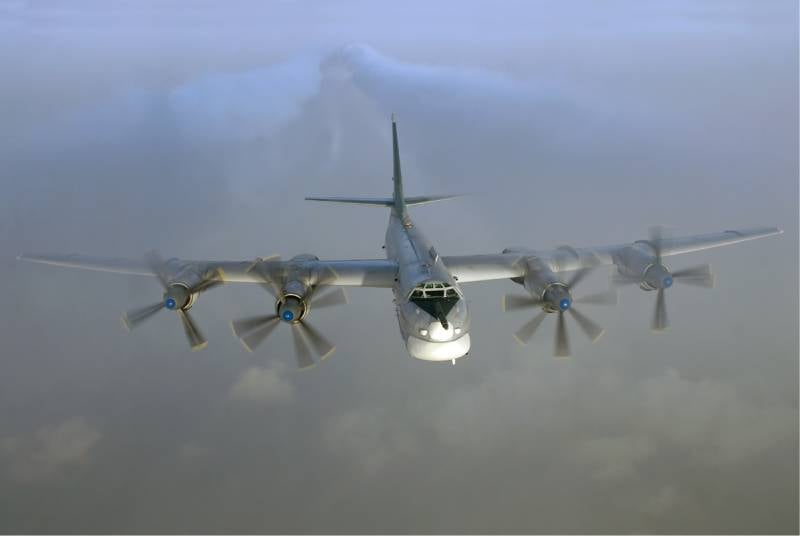
Russian special military operation (SVO) in Ukraine revealed the highest vulnerability aviation equipment from the means of air defense (air defense) of the enemy. Almost from the very beginning of the NWO in the news periodically there is information that another plane or helicopter of the Russian air force (VVS) has been shot down. Worst of all, this information is often confirmed by the fact that Russian military pilots are captured by the Armed Forces of Ukraine (AFU), where they are subjected to torture and abuse, not condemned by the so-called “free world”.
Of course, if you listen to the Ukrainian media, then Russian aviation has already been completely destroyed, and several times in a row. However, for some Russian media and official sources of information, one can also note the sin of exaggerating our achievements in terms of destroying enemy aircraft.
The main burden of the struggle during the NWO lies with Tanks и other armored vehicles, artillery and multiple launch rocket systems (MLRS), except for unmanned aerial vehicles (UAVs), including UAV-kamikaze, added novelty to the course of hostilities.
The massive use of infantry, armored vehicles and artillery is a consequence of inability of the RF Armed Forces to seize air supremacy over Ukraine. And we cannot seize air supremacy because of the vulnerability of our aviation equipment to enemy anti-aircraft missile systems (SAM).
Ways to protect
There are various ways to potentially reduce the loss of aircraft and helicopters - using electronic warfare (EW), setting infrared (IR) interference, using active countermeasures for homing heads (GOS) of attacking anti-aircraft guided missiles (SAM) of the enemy, reducing the radar and thermal visibility of aircraft and helicopters, but there are nuances.
Domestic electronic warfare equipment, from which “the American destroyer Donald Cook fled in disgrace from the Black Sea,” for some reason did not close the sky over Ukraine - radar-guided missiles periodically fly into our planes. Conventional IR jamming systems - heat traps, are far from always able to disrupt the capture of modern IR seeker with digital signal processing. Complexes of active countermeasures of the Vitebsk-type IR seeker, including not only heat traps and dipole reflectors, but also laser irradiation detection equipment, ultraviolet missile launch direction finders and optoelectronic suppression stations (SOEP), apparently, are more effective, but nevertheless , and they do not always provide protection against missiles, especially if the enemy releases several of them at the same time.
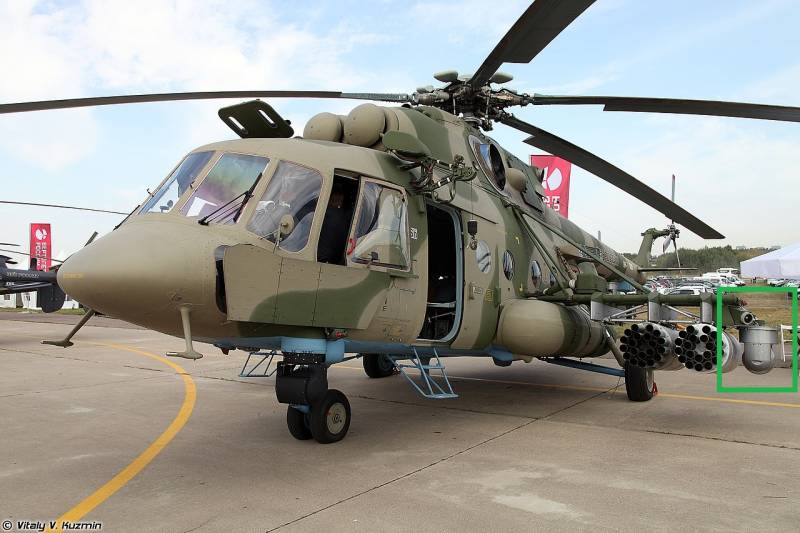
The Mi-8AMTSh helicopter, equipped with the L-370E8 Vitebsk airborne defense system, shows ultraviolet direction finders of the fact of missile launches and optoelectronic suppression stations. Image by wikipedia.org
As for measures to reduce thermal and radar visibility, they must be implemented at the design stage of the aviation complex. So far, we have only one such machine - this is the Su-57 multifunctional fighter, and even then, in the troops of these aircraft, we can say that they are not.
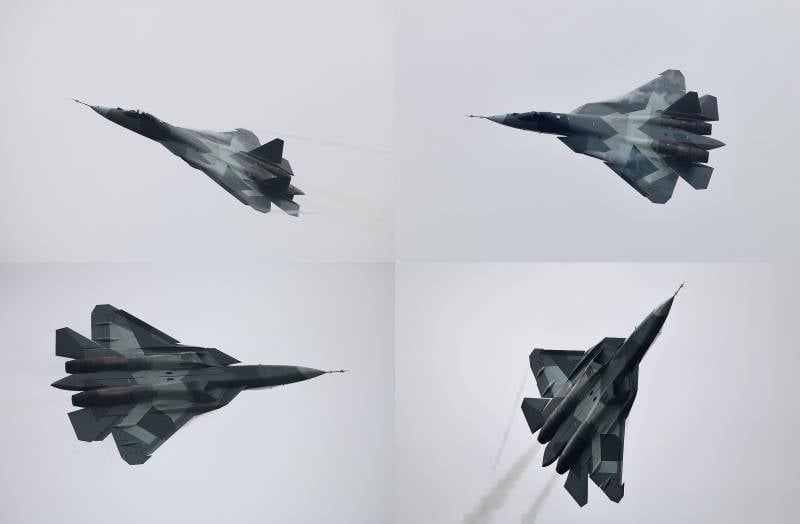
The Su-57 multifunctional fighter is still a rare bird in the Russian Air Force. Image by wikipedia.org
The above measures only make it possible to deceive the means of guidance for missiles or partially disrupt their functioning, but these measures are not sufficiently reliable. As practice shows, functional counteraction is unstable, the most reliable way of self-defense of protected objects is the physical destruction of attacking ammunition.
Trends in the development of aviation means of active protection
The idea of increasing the security of aviation by directly destroying enemy attack weapons, such as air-to-air (A-A) missiles or SAMs, has been in the air for a long time.
First of all, we are talking about the interception of attacking ammunition with the defending aircraft's own V-V missiles. Moreover, there are two options, the simplest of which is to use your own V-V missiles to intercept V-V missiles. The problem is that their number on board the aircraft is limited, and having intercepted one or two enemy missiles, you yourself can be left without ammunition.
The second option is the creation of specialized anti-missiles with reduced dimensions and range, designed specifically to intercept V-V and SAM missiles. Such products, presumably, can be taken on board several times more. However, like modern V-V missiles, these will be expensive high-tech solutions, including active radar homing heads (ARLGSN) or infrared homing heads (IKGSN), or even more expensive combined solutions.
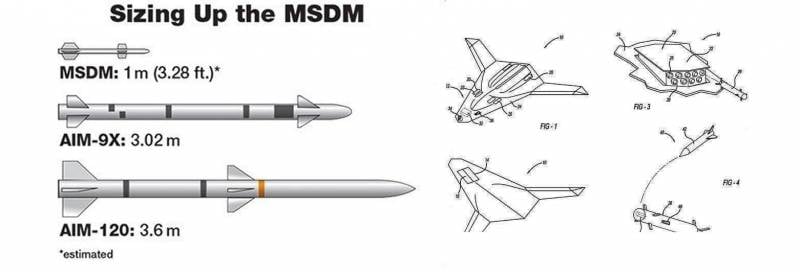
Comparison of the dimensions of American B-B missiles and the promising B-B MSDM anti-missile, as well as an image from a Northrop Grumman patent for a defensive ammunition launch system for combat aircraft
We previously considered this issue in the material Air-to-air anti-missile missiles.
A radical way to reduce the cost of self-defense of aviation systems is laser weapon. It is still perceived by many with skepticism - they say, how will you power it, how will you cool it, they remember silver paint, bad weather, and so on and so forth ... We have repeatedly discussed the prospects for the development of laser weapons, including on aviation media, for example, in the article Laser weapons on combat aircraft. Is it possible to resist him?, and we will definitely return to this issue in the future.
Despite the opinion of skeptics, The US military has already begun testing a 300 kW combat laser system.. It's a lot. A weapon of such power is capable of intercepting any V-V missile or missile.
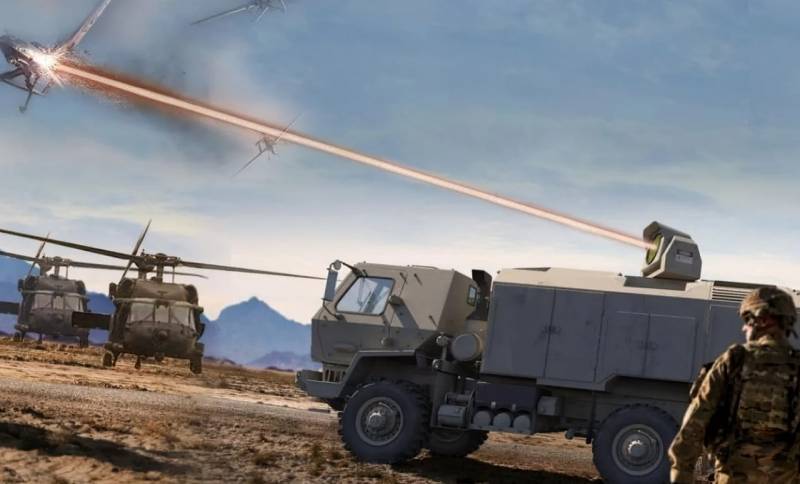
Image of a HELSI combat laser with a power of up to 300 kW developed by Lockheed Martin
Someone will say that this is just a ground demonstrator. Yes, this is true, but a few years ago, the maximum power of the tested samples did not exceed 150 kW, and a few years earlier, 15-50 kW. And these are not some gas-dynamic or chemical lasers, but modern compact models based on solid-state / fiber lasers with spectral alignment of radiation. Progress is clearly moving very quickly. And for example, in a bomber or in a transport plane there is a place for such a “truck” - a small price to pay for the opportunity not to be afraid of enemy missiles.
Given that aircraft and helicopters do not need to “cut” ships and Tanks, and they fly much higher than fogs and dust-smoke screens, then the prospects for laser weapons are grandiose, and the higher the aircraft (LA) is, the more effectively it will be able to use laser self-defense weapons.
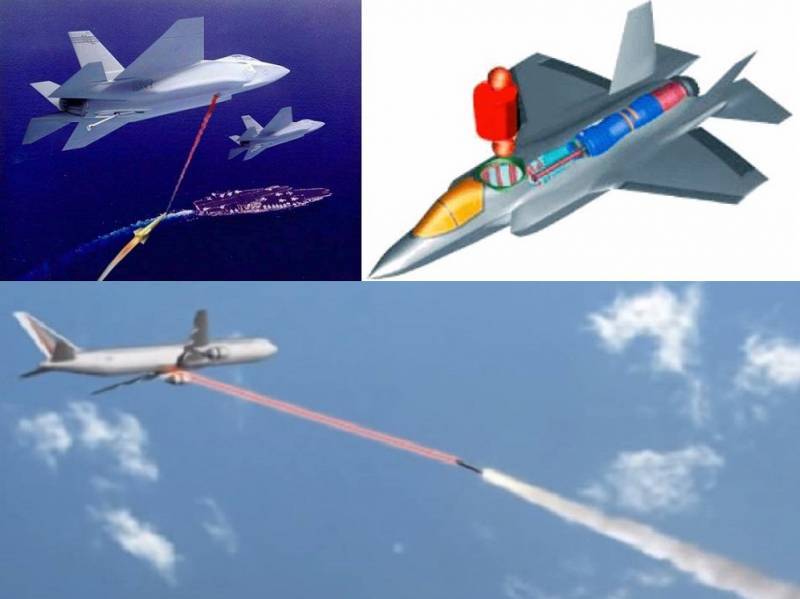
The US Armed Forces plan to deploy laser defense systems both on transport aircraft and bombers, and on tactical aircraft and helicopters
Perhaps the newest American B-21 Raider bomber, the presentation of which should take place at the end of 2022, will become a reference point in the use of laser weapons on combat aircraft, it is possible that he will become something much more than an ordinary bomber.
Are powerful high-performance lasers being developed in Russia that could potentially be installed on aircraft and helicopters of various classes?
This is an open question, even if something is being developed, then under a thick veil of secrecy.
Are specialized small-sized air-to-air missiles being developed in Russia?
With them, most likely, even more difficult. Even if such V-V anti-missiles are developed, they will be expensive, there will be few of them in service. To be convinced of this, it is enough to look at how long the RVV-SD missiles went to the troops, and what is most often dropped on the head of the Armed Forces of Ukraine during a special operation in Ukraine (ordinary "cast iron").
If the prospects for creating combat aviation systems for laser weapons in Russia are still in question, and the number of purchased V-V anti-missiles will inevitably be limited by their undoubtedly high cost, then perhaps it is worth considering other ways to increase the security of aircraft and helicopters, for example, active protection systems?
KAZ - for armored vehicles, and not only
Active protection systems for armored vehicles have long become commonplace - KAZs have been developed in different countries for a long time, many variants of KAZ have been developed, and even more concepts have been formed. Unfortunately, despite the fact that Soviet specialists can be considered pioneers in the creation of KAZ, neither the Soviet nor the Russian army, in fact, received serial KAZ into service. We can say that Israel has the greatest experience in the real use of KAZ with its widely advertised ASPRO-A Trophy complex.
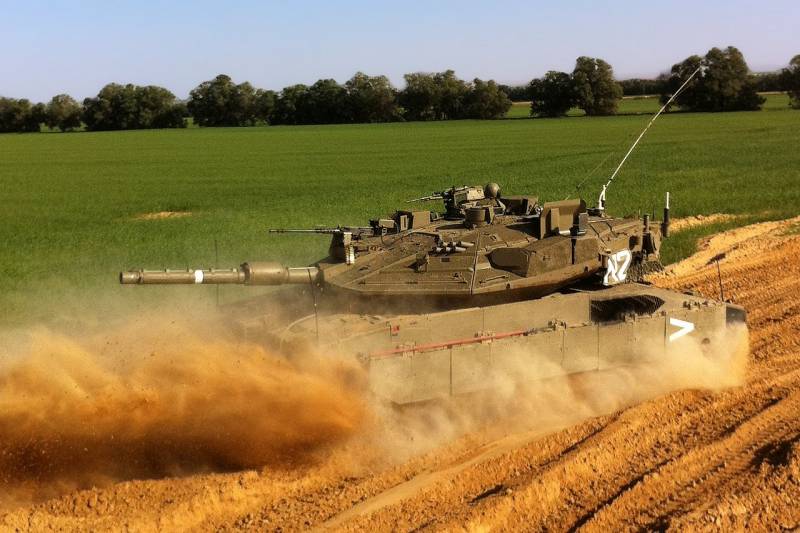
So far, KAZ is widely used only on Israeli Merkava tanks.
Previously, we considered various options for active protection complexes, for example, KAZ-PVO - complex of active protection of air defense, KAZ-NK - active protection systems for surface ships и "Octopus" - a complex of active anti-torpedo defense of submarines.
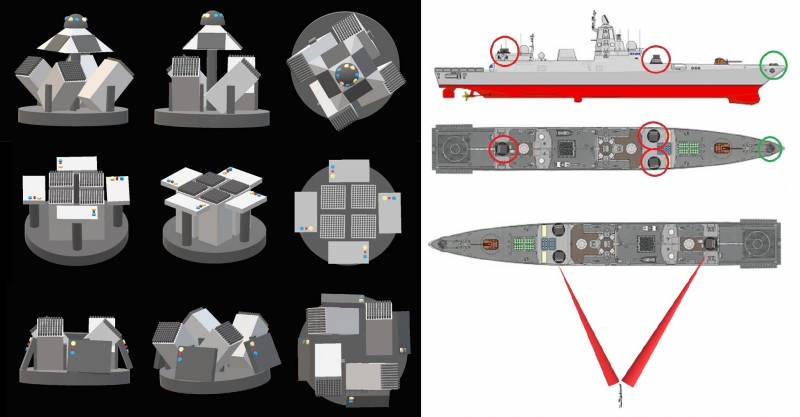
Concepts KAZ-Air Defense and KAZ-NK
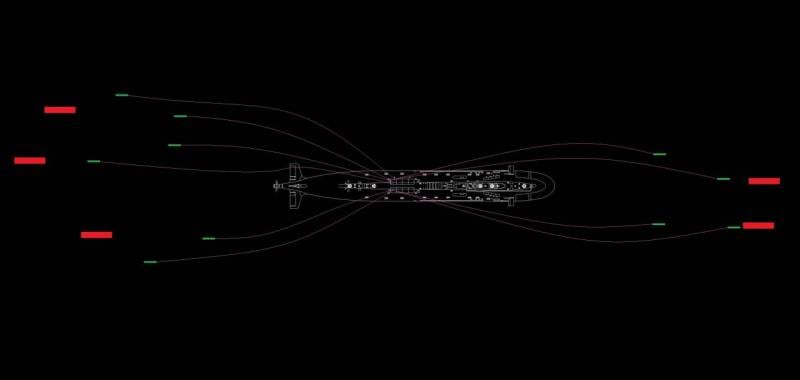
The active anti-torpedo protection complex, in combination with the small-sized anti-torpedoes of the Paket-PL complex, can significantly increase the survivability of Russian SSBNs and ICAPLs
A distinctive feature of active defense systems is the defeat of attacking ammunition at a minimum distance, as well as the use of unguided ammunition (the exception is the concept of the Sprut active anti-torpedo protection complex, where the ammunition is guided, but this is a consequence of the specifics of the application environment, however, in this case, the expediency of using unguided protective ammunition cannot be completely ruled out).
It can be assumed that active protection systems can also be developed for placement on aircraft and helicopters of various classes. Let's try to consider what a promising complex of active protection of aviation equipment (KAZ-AT) might look like.
KAZ-AT
We need to protect aviation equipment from two main types of threats - surface-to-air (S-A) missiles, that is, missiles launched by ground-based and ship-based air defense systems, and air-to-air (A-A) missiles launched by enemy planes and helicopters. Of course, there is also anti-aircraft artillery, but both guided anti-missiles and KAZ-AT are likely to be useless against shells, and self-defense laser systems will also be of little use.
On the other hand, as we have already said in the material Where will the combat aircraft go: will it press down on the ground or gain altitude??, it is best to protect aviation equipment from attacking ammunition at high altitude, where it will have room for maneuver, clear skies for long-range visibility and the ability to build a layered defense due to the successive destruction of attacking ammunition by guided V-V anti-missiles, laser weapons and, finally, KAZ-AT. And at high altitude, shells cannot reach airplanes and helicopters, as well as promising enemy ground / ship laser weapons (the range of these systems will be limited).
Attack ammunition can be roughly divided into two types. The first type is ammunition containing a high-explosive fragmentation / rod or other warhead filled with an explosive and detonated near the target. The second type is the ammunition of a direct, so-called kinetic hit.
Characteristically, the second type - ammunition for direct kinetic destruction of the target is considered more modern and more dangerous, it is they who are capable of inflicting maximum damage on targets and causing detonation of ballistic missile warheads.
In any case, in the final section of its flight path, the last 100-200 meters, the V-V missile or SAM can no longer practically maneuver, both due to lack of time for this, and often due to lack of energy (especially when firing maximum range or close to it). Moreover, now such a task is not set - the main thing is to hit the target as quickly and accurately as possible.
Thus, V-V and SAM missiles are, albeit high-speed, but straight-flying targets. Unlike air-to-ground (A-G) munitions, gravity plays against the A-B missiles and missiles, with any damage, their trajectory will quickly begin to deviate downward. Even anti-ship missiles flying parallel to the earth's surface, after hitting a missile defense system in the final section, by inertia can fly to the attacked ship, at least their fragments. For V-V and SAM missiles, this is more difficult to do - a downed missile, most likely, will not get anywhere.
As in the case of KAZ-PVO and KAZ-NK, two types of ammunition can be considered to destroy V-V and SAM missiles - shrapnel and unguided munitions with remote detonation on the trajectory. It can be assumed that the best solution would be the simultaneous use of KAZ-AT as part of the ammunition load, while ammunition with remote detonation on the trajectory should hit V-V and SAM missiles at a greater distance - about 100-200 meters, since there will already be a risk of hitting the protected shrapnel from the ammunition protecting it. In turn, shrapnel ammunition should work at a distance of up to 100 meters, then the dispersion of damaging elements, presumably, will become too large to provide an acceptable probability of hitting the target.
How can you place damaging ammunition?
It can be assumed that it will be something like containers suspended under the wing / fuselage of aircraft - something like launchers (PU) of unguided aircraft missiles (NAR). Additionally, launchers can be equipped with flaps that reduce their resistance to air flow and reduce the effective dispersion surface (ERA). However, hanging containers in any case will increase the overall RCS of aircraft. Suspended containers must be equipped with mechanisms for extremely fast turnaround and targeting of attacking V-V missiles or missiles.
The main problem of KAZ-AT is the timely detection of attacking V-V and SAM missiles, the calculation of their trajectory and the turn of launchers of damaging ammunition in their direction.
Is it possible to implement KAZ-AT on the basis of detection and tracking systems for active counteraction to infrared (IR) homing heads (GOS) of the Vitebsk type? Hardly. Of course, potentially complexes like "Vitebsk" can and should be integrated into a single whole. It is possible that KAZ-AT will be created on the basis of complexes of active counteraction to the IR seeker. But it must be understood that the accurate defeat of attacking V-V missiles or missiles will require the issuance of accurate target designation to the KAZ-AT weapons, which can only be provided by radar detection tools. Thus, KAZ-AT should include small-sized radar stations (RLS) conformally placed on the aircraft body in such a way as to provide all-round visibility. It is possible that the KAZ-AT detection radars can be made on the basis of solutions for active protection systems for armored vehicles.
KAZ-AT operation algorithm
Two modes of operation of KAZ-AT can be implemented: passive and active.
After climbing, the pilot activates the KAZ-AT, after which it switches to fully automatic operation. IR and ultraviolet (UV) radiation sensors continuously survey the surrounding area in order to detect attacking I-V missiles or missiles. In this mode, KAZ-AT does not emit anything, without unmasking the aircraft on which it is installed - this is the basic, passive mode of operation. In case of detection of a launch of a V-V missile or a missile defense system, the KAZ-AT switches to active mode - the target detection radars are turned on.
It can be assumed that in most cases it is the active mode of operation of KAZ-AT that will become the main one, enabled by default. Low-power short-range radars do not unmask an airplane or helicopter so much, but at the same time, the chance to miss an attacking V-V missile or missile defense system will decrease by an order of magnitude.
Presumably, KAZ-AT will have limited defense sectors, that is, it is unlikely that it will be possible to provide launcher guidance in the range of 360 degrees horizontally and vertically. Most likely, these will be conventionally rectangular conical sectors ahead and behind the aircraft.
In the event that attacking ammunition is detected in advance and directed at them by IR and UV sensors at a long range, the protected aircraft will receive an alarm signal in advance and information about the need to turn the nose / tail part towards the attacking ammunition in order for them to fall into the kill zone of the KAZ- launcher AT. A variant of deep integration of the control systems of the aircraft and KAZ-AT can be considered, when in a number of situations the aircraft will return to the required position of the launcher automatically.
When entering the affected area, attacking V-V missiles or SAMs must be fired at sequentially with protective ammunition of various types until they are destroyed. It can be assumed that the optimal solution would be the obligatory simultaneous-sequential (the delay between their use will be scanty) firing of ammunition with a remotely detonated warhead and shrapnel ammunition.
Priorities for the use of KAZ-AT
On what types of aircraft can KAZ-AT be deployed? It would seem that, first of all, these should be the most expensive and high-tech combat vehicles of the Russian Air Force, such as the Su-57 multifunctional fifth-generation fighter and the Tu-160M strategic bomber-missile carrier. However, the specifics of these machines will make the integration of KAZ-AT on them a rather difficult task.
The Su-57 is an inconspicuous aircraft, and the placement of KAZ-AT hanging containers on it will deprive it of this advantage, not to mention the need for a conformal placement of the radar on the fuselage. Similarly, on the Tu-160M, hanging containers will dramatically increase aerodynamic drag, especially at supersonic speeds.
Thus, it is advisable to place KAZ-AT complexes on Su-57 or Tu-160M type vehicles only in the course of modernization, through deep integration into the aircraft design.
Then where is it advisable to use KAZ-AT?
First of all, these are subsonic aircraft, such as Tu-95 bombers, Su-25SM attack aircraft, Ka-52 and Mi-28M / NM helicopters, Il-96 transport aircraft and vehicles based on them, such as tanker aircraft or long-range aircraft radar weapons (DRLO). It is on these machines, which are extremely vulnerable to V-V and SAM missiles, that the potential of KAZ-AT can be fully revealed.

Tu-95, Su-25, Ka-52, Mi-28, A-50, Il-76 are the first contenders for the installation of KAZ-AT. Image by wikipedia.org
They can be followed by such vehicles as the Su-30SM, Su-34, Su-35, MiG-35 and others, that is, vehicles of the fourth generation (no matter how many pluses they are given). The integration of KAZ-AT on them will be more difficult, since they can fly at supersonic speeds and maneuver with high overloads, however, it is quite real.
It's funny, but it can be assumed that the best candidate for the installation of KAZ-AT is the American B-52 bomber, the service life of which, apparently, will exceed 100 years! This machine combines a reliable, albeit outdated, basic design, complemented by the latest technical solutions, up to a radar with an active phased array antenna (AFAR) - the experience of creating and extending the life cycle of this combat vehicle must be used.

B-52 and Tu-95 - it is unlikely that we will see this again soon, if we ever see it at all ...
Aftermath
Suppose we have integrated KAZ-AT on the Tu-95MSM, what will this lead to?
The enemy will be damaged even without combat.
How so?
For example, Tu-95MSM, equipped with KAZ-AT, patrols the waters over the Norwegian Sea. As always, one of the NATO countries sends a fighter jet to accompany him, for example, the latest F-35. But, given the limited ammunition load of V-V missiles installed in the F-35 weapons bay, the enemy cannot be sure that he will overcome the capabilities of the KAZ-AT. As a result, two or even four cars will need to be sent for escort. And this is an additional expense for the cost of a flight hour, the consumption of engine life, the number of takeoffs and landings of weapons - rather big money.
But the main thing, of course, is not to "nightmare" enemies in peacetime. The main thing is to increase the security of Russian aircraft in wartime conditions.
For example, in the course of the NMD in Ukraine, Russian aviation could escape from low altitudes, avoiding the fire of man-portable air defense systems (MANPADS). Strategic missile bombers could constantly "hang" over the front line and any important objects that require timely destruction. Russian aviation would be able to fully seize air supremacy and operate in the depths of Ukrainian territory.
The armed forces of Ukraine do not have enough missiles to launch dozens of Russian aircraft out of the direction, most often it is one or two missiles that KAZ-AT should potentially be able to handle. In addition, the long-term operation of the Ukrainian air defense systems in the active mode would quickly lead to their detection and destruction - now their tactics are more like “hit and run”.
At one time, a lot was said about some "plasma generators" that will turn our, even obsolete, aircraft into "invisibles". Well, somehow it didn’t grow together with the “plasma”, and the Russian Air Force clearly lacks modern stealth aircraft. This means that it is necessary to look for other approaches - let the enemy be able to detect our aircraft, but he should have problems with its destruction.
It can be assumed that the creation of kits of the KAZ-AT type should become one of the most important priorities of the Russian Air Force. At the same time, one should not forget about other ways to increase the security of aircraft, such as the creation of air-to-air anti-missiles, laser self-defense systems and electronic warfare systems. Their rational combination within the framework of one aircraft will make it, if not “invulnerable”, then maximally protected from the impact of enemy air-to-air missiles and missiles.
Information